Verification Platform of SOC Estimation Algorithm for Lithium-Ion Batteries of Electric Vehicles
Abstract
:1. Introduction
2. Design Idea of Verification Platform
2.1. Research and Development Purpose
2.2. Functional Requirements
2.3. Overall Design Scheme
3. Hardware Structure Design
3.1. BMS Host Module
3.2. BMS Slave Module
3.3. Battery Charger Module
3.4. Programmable Electronic Load Module
4. Software System Design
4.1. Communication Framework between Modules
4.2. Reference Standard of SOC and Evaluation Indexes of Method
4.2.1. Reference Standard of Battery Cell SOC
4.2.2. Reference Standard of Battery Pack SOC
- (1)
- Series connection battery pack SOC
- (2)
- Parallel connection battery pack SOC
- (3)
- Hybrid connection battery pack SOC
4.3. Function and Implementation of Upper Computer
5. Results Analysis
6. Conclusions
Author Contributions
Funding
Institutional Review Board Statement
Informed Consent Statement
Data Availability Statement
Acknowledgments
Conflicts of Interest
Nomenclature
| AAE | Average absolute error |
| AC/DC | Alternating current/Direct current |
| AD | Analog to Digital |
| AVM | Average value method |
| BMS | Battery management system |
| BPNN | Back-propagation neural network |
| CAN | Controller area network |
| CPU | Central processing unit |
| DST | Dynamic Stress Test |
| EKF | Extend Kalman filter |
| ET | Estimation time |
| EUDC | Extra Urban Driving Cycle |
| EVs | Electric vehicles |
| FSR | Full scale range |
| FUDS | Federal Urban Driving Schedule |
| GA-BPNN | Genetic algorithm optimized back-propagation neural network |
| HIL | Hardware-in-the-loop |
| MAE | Maximum absolute error |
| NEDC | New European Driving Cycle |
| OCV | Open circuit voltage |
| RMSE | Root mean square error |
| RBFNN | Radial basis function neural network |
| RS | Recommended Standard |
| SOC | State of charge |
| SCM | Special cell method |
| SPI | Serial Peripheral Interface |
| UDDS | Urban Dynamometer Driving Schedule |
| UKBC | United Kingdom Bus Cycle |
References
- Jinhao, M.; Guangzhao, L.; Mattia, R.; Maciej, S.; Daniel-Ioan, S.; Remus, T. Overview of lithium-ion batteries modeling methods for state-of-charge estimation in electrical vehicles. Appl. Sci. 2018, 8, 659. [Google Scholar]
- Zhang, N.; Zhou, Y.; Tian, Q.; Liao, X.; Zhang, F. A Novel Method for Estimating State-of-Charge in Power Batteries for Electric Vehicles. Int. J. Precis. Eng. Manuf. 2019, 20, 845–852. [Google Scholar] [CrossRef]
- Xu, G.; Du, X.; Li, Z.; Zhang, X.; Zheng, M.; Miao, Y.; Gao, Y.; Liu, Q. Reliability design of battery management system for power battery. Microelectron. Reliab. 2018, 88–90, 1286–1292. [Google Scholar] [CrossRef]
- Li, L.; Li, Z.; Zhao, J.; Guo, W. Lithium-ion batteries Management System for Electric Vehicles. Int. J. Perform. Eng. 2018, 14, 3184–3194. [Google Scholar] [CrossRef] [Green Version]
- Salehen, P.; Su’Ait, M.; Razali, H.; Sopian, K. Development of battery management systems (BMS) for electric vehicles (EVs) in Malaysia. MATEC Web Conf. 2016, 90, 1001. [Google Scholar] [CrossRef] [Green Version]
- Chen, Z.; Li, X.; Shen, J.; Yan, W.; Xiao, R. A Novel State of Charge Estimation Algorithm for Lithium-Ion Battery Packs of Electric Vehicles. Energies 2016, 9, 710. [Google Scholar] [CrossRef]
- Zhang, Y.; Xiong, R.; He, H.; Shen, W. Lithium-Ion Battery Pack State of Charge and State of Energy Estimation Algorithms Using a Hardware-in-the-Loop Validation. IEEE Trans. Power Electron. 2017, 32, 4421–4431. [Google Scholar] [CrossRef]
- Sheng, J. Test Verification System of New Energy Automobile Power Battery SOC Estimation Tactics. China Patent CN201620496696.6, 13 February 2016. [Google Scholar]
- Guo, B.; Zhang, P.; Wang, W. Research on SOC estimation of LiFePO4battery based on OCV-SOC curve cluster. Chin. J. Power Sources 2019, 43, 1125–1128. [Google Scholar]
- Guo, L.; Li, J.; Fu, Z. Lithium-Ion Battery SOC Estimation and Hardware-in-the-Loop Simulation Based on EKF. Energy Procedia 2019, 158, 2599–2604. [Google Scholar] [CrossRef]
- He, Y.; Liu, W.; Koch, B.J. Battery algorithm verification and development using hardware-in-the-loop testing. J. Power Source 2010, 195, 2969–2974. [Google Scholar] [CrossRef]
- Zhang, W.; Sun, X.; Lei, W. Battery Pack State of Charge Estimation and Hardware in Loop System Design Verification. In Proceedings of the 2017 9th International Conference on Intelligent Human-Machine Systems and Cybernetics (IHMSC), Hangzhou, China, 26–27 August 2017. [Google Scholar]
- Xia, B.; Chen, G.; Zhou, J.; Yang, Y.; Huang, R.; Wang, W.; Lai, Y.; Wang, M.; Wang, H. Online Parameter Identification and Joint Estimation of the State of Charge and the State of Health of Lithium-Ion Batteries Considering the Degree of Polarization. Energies 2019, 12, 2939. [Google Scholar] [CrossRef] [Green Version]
- Xie, S.; Xiong, R.; Zhang, Y.; He, H. The Estimation of State of Charge for Power Battery Packs used in Hybrid Electric Vehicle. Energy Procedia 2017, 105, 2678–2683. [Google Scholar] [CrossRef]
- Xia, B.; Guo, S.; Wang, W.; Lai, Y.; Wang, H.; Wang, M.; Zheng, W. A State of Charge Estimation Method Based on Adaptive Extended Kalman-Particle Filtering for Lithium-ion Batteries. Energies 2018, 11, 2755. [Google Scholar] [CrossRef] [Green Version]
- Singh, K.V.; Bansal, H.O.; Singh, D. Hardware-in-the-loop Implementation of ANFIS based Adaptive SoC Estimation of Lithium-ion Battery for Hybrid Vehicle Applications. J. Energy Storage 2020, 27, 101124. [Google Scholar] [CrossRef]
- Cui, D.; Xia, B.; Zhang, R.; Sun, Z.; Lao, Z.; Wang, W.; Sun, W.; Lai, Y.; Wang, M. A Novel Intelligent Method for the State of Charge Estimation of Lithium-Ion Batteries Using a Discrete Wavelet Transform-Based Wavelet Neural Network. Energies 2018, 11, 995. [Google Scholar] [CrossRef] [Green Version]
- Gismero, A.; Schaltz, E.; Stroe, D.-I. Recursive State of Charge and State of Health Estimation Method for Lithium-Ion Batteries Based on Coulomb Counting and Open Circuit Voltage. Energies 2020, 13, 1811. [Google Scholar] [CrossRef] [Green Version]
- Zhang, G.; Xia, B.; Wang, J. Intelligent state of charge estimation of lithium-ion batteries based on L-M optimized back-propagation neural network. J. Energy Storage 2021, 44, 103442. [Google Scholar] [CrossRef]
- Xiong, R.; Sun, F.; Gong, X.; He, H. Adaptive state of charge estimator for lithium-ion cells series battery pack in electric vehicles. J. Power Source 2013, 242, 699–713. [Google Scholar] [CrossRef]
- Sun, F.; Xiong, R.; He, H. A systematic state-of-charge estimation framework for multi-cell battery pack in electric vehicles using bias correction technique. Appl. Energy 2016, 162, 1399–1409. [Google Scholar] [CrossRef]
- Xiong, R.; He, H.; Sun, F.; Zhao, K. Online Estimation of Peak Power Capability of Li-Ion Batteries in Electric Vehicles by a Hardware-in-Loop Approach. Energies 2012, 5, 1455–1469. [Google Scholar] [CrossRef]
- Fan, B.; Luan, X.; Zhang, R.; Niu, T.; Xie, Y. Research on SOC Estimation Algorithm for Lithium Battery Based on EKF Algorithm and Ampere-hour Integration Method. In Proceedings of the 2017 2nd International Conference on Electrical, Control and Automation Engineering (ECAE 2017), Xiamen, China, 24–25 December 2017. [Google Scholar] [CrossRef] [Green Version]
- Ren, G.; Lin, Y.; Sun, Z.; Shao, Y. SOC Estimation of Mine Power Supply Based on Improved BP Neural Network Algorithm. IOP Conf. Ser. Earth Environ. Sci. 2020, 526, 012112. [Google Scholar] [CrossRef]
- Wang, L.; Zhou, H.; Yang, J.; Xiong, Y.; She, J.; Chen, W. A decision support system for tobacco cultivation measures based on BPNN and GA. Comput. Electron. Agric. 2021, 181, 105928. [Google Scholar] [CrossRef]
- Zheng, Y.; Ouyang, M.; Lu, L.; Li, J.; Han, X.; Xu, L.; Ma, H.; Dollmeyer, T.A.; Freyermuth, V. Cell state-of-charge inconsistency estimation for LiFePO4 battery pack in hybrid electric vehicles using mean-difference model. Appl. Energy 2013, 111, 571–580. [Google Scholar] [CrossRef]
- Hou, Z.; Xie, P.; Hou, J. The state of charge estimation of power lithium battery based on rbf neural network optimized by particle swarm optimization. J. Appl. Sci. Eng. 2017, 20, 483–490. [Google Scholar]
- Zhang, L.; Zheng, M.; Du, D.; Li, Y.; Fei, M.; Guo, Y.; Li, K. State-of-Charge Estimation of Lithium-Ion Battery Pack Based on Improved RBF Neural Networks. Complexity 2020, 2020, 8840240. [Google Scholar] [CrossRef]
- Li, Y.; Wei, Z.; Xiong, B.; Vilathgamuwa, D.M. Adaptive Ensemble-Based Electrochemical-Thermal-Degradation State Estimation of Lithium-ion Batteries. IEEE Trans. Ind. Electron. 2022, 69, 6984–6996. [Google Scholar] [CrossRef]
- Zhang, D.; Couto, L.D.; Moura, S.J. Electrode-Level State Estimation in Lithium-ion Batteries via Kalman Decomposition. IEEE Control. Syst. Lett. 2020, 5, 1657–1662. [Google Scholar] [CrossRef]
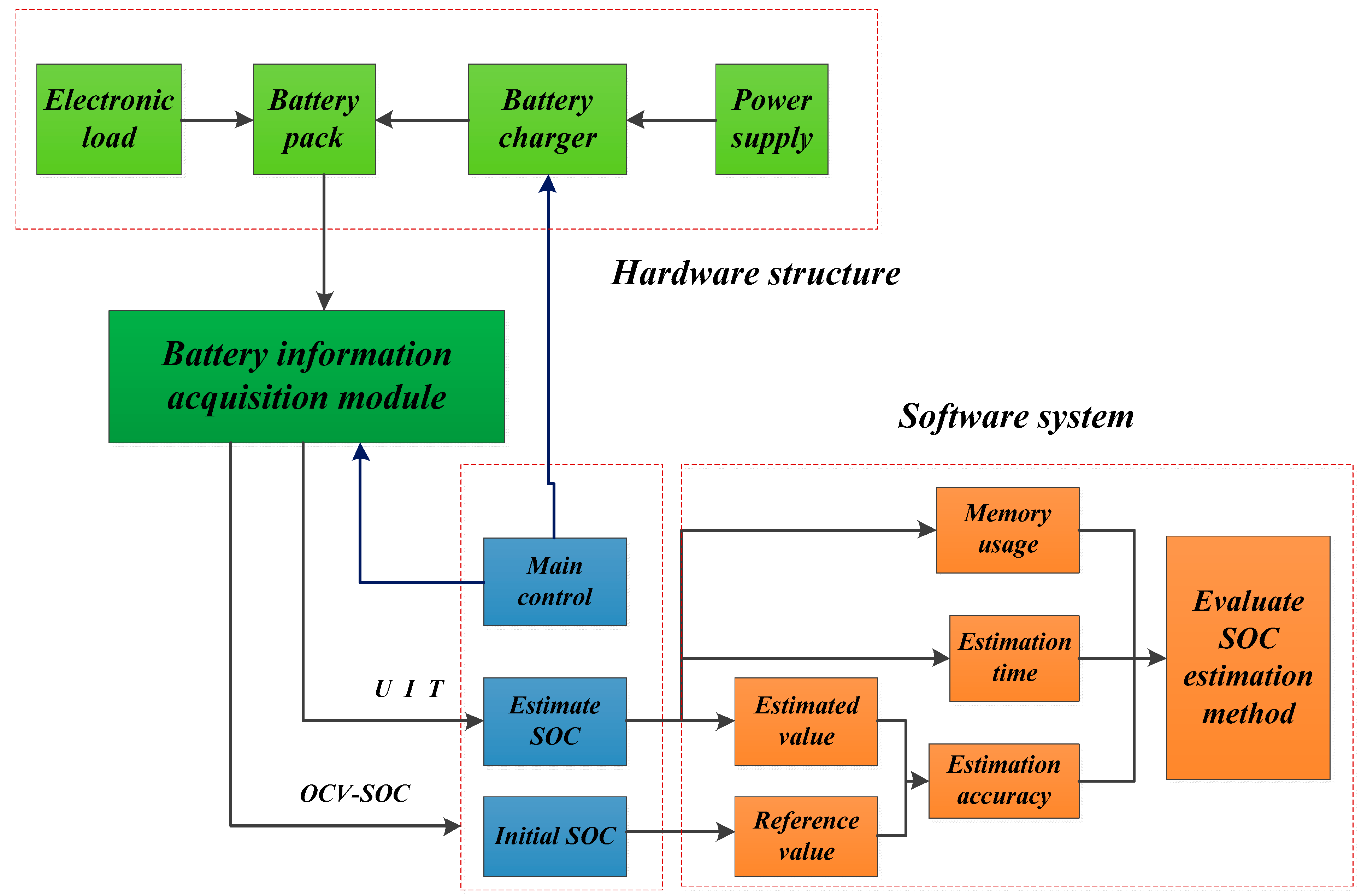
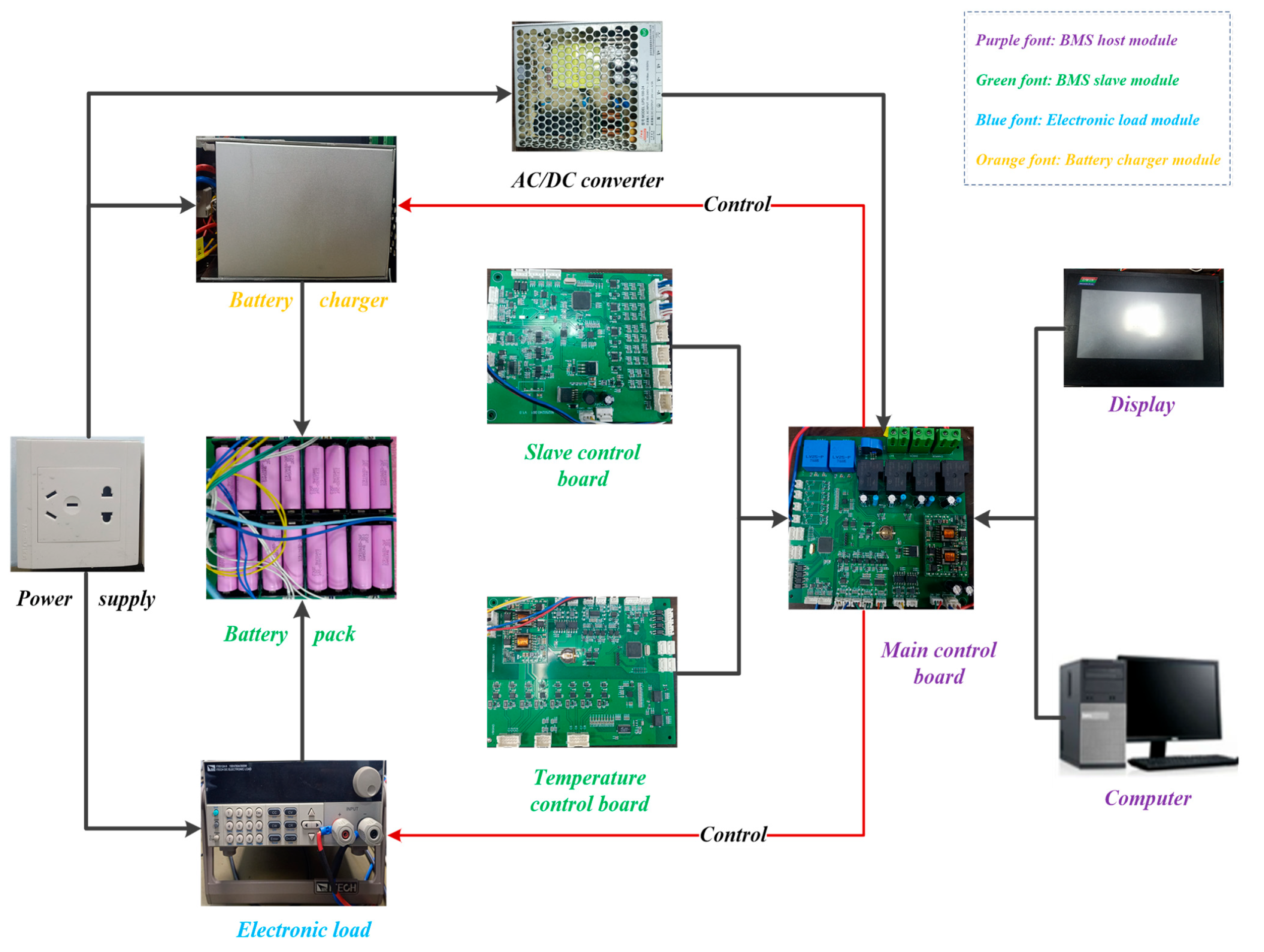


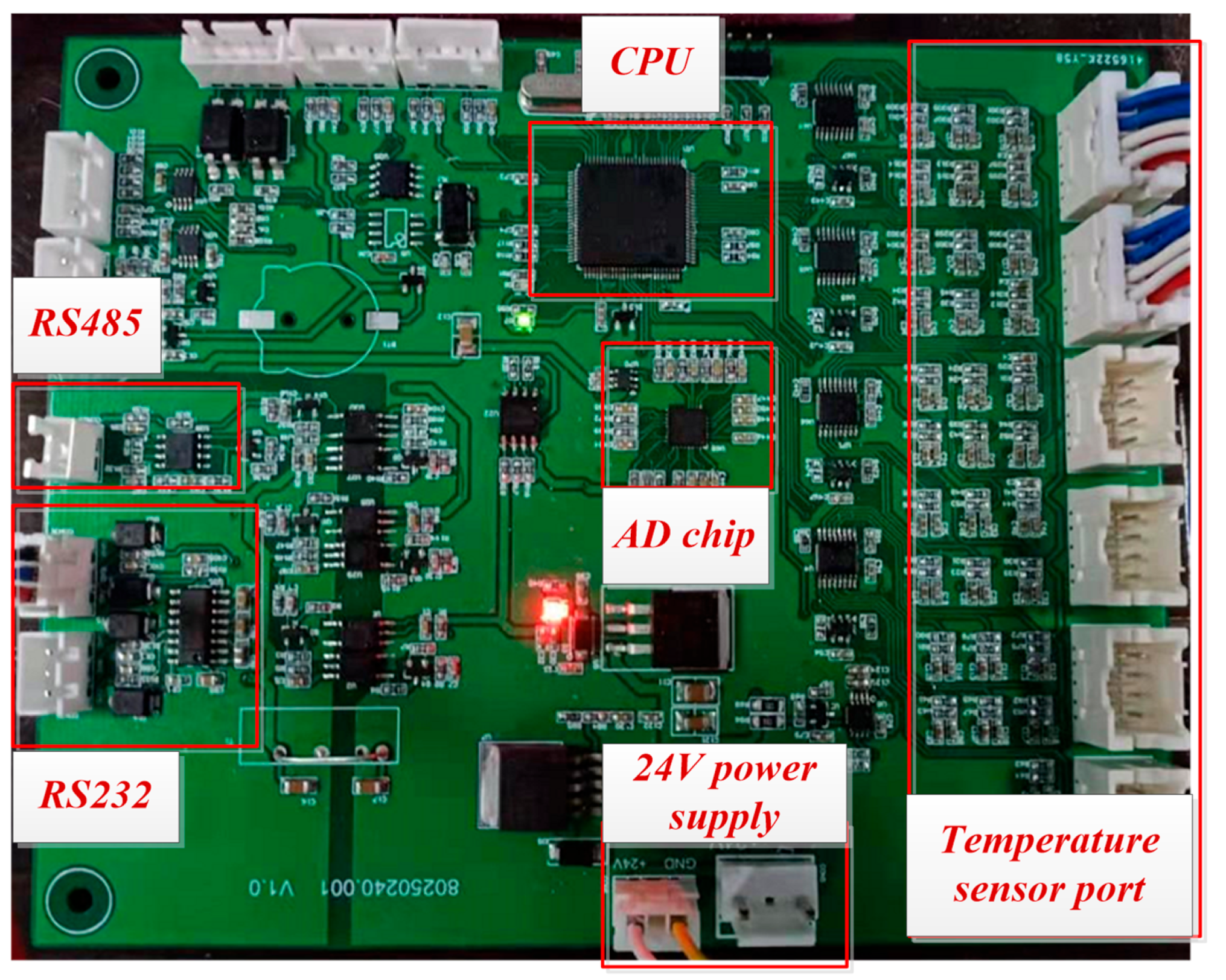
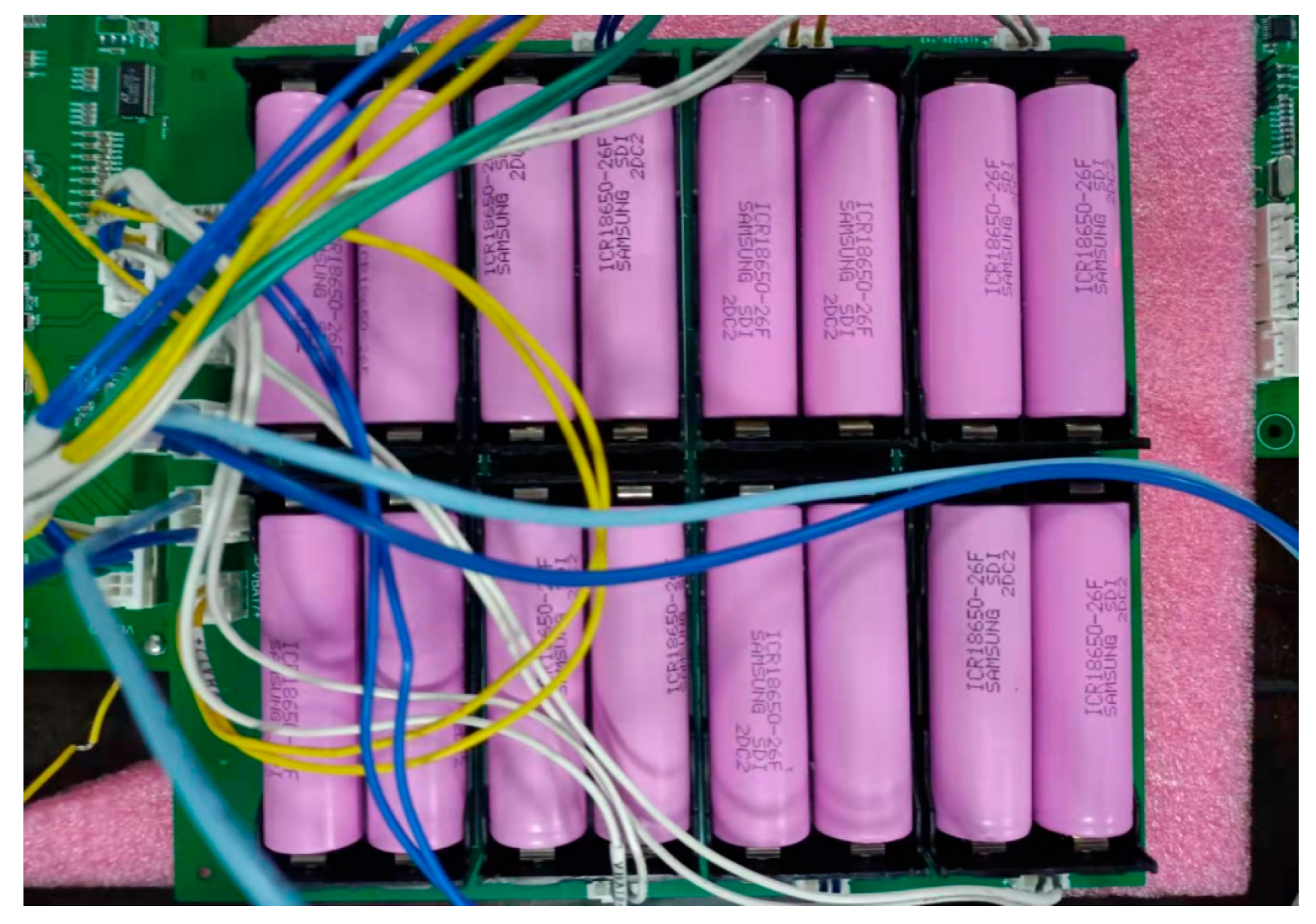
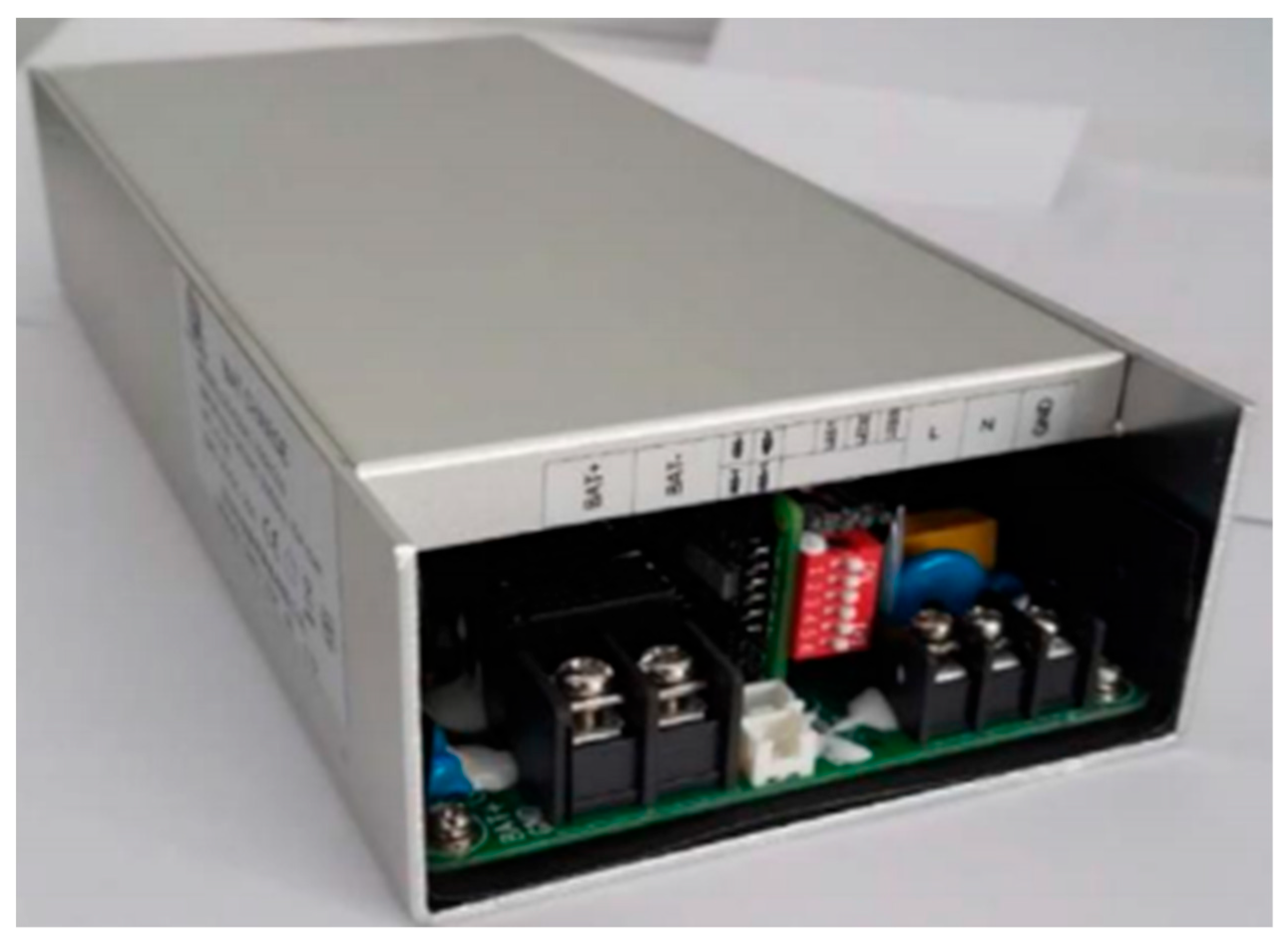
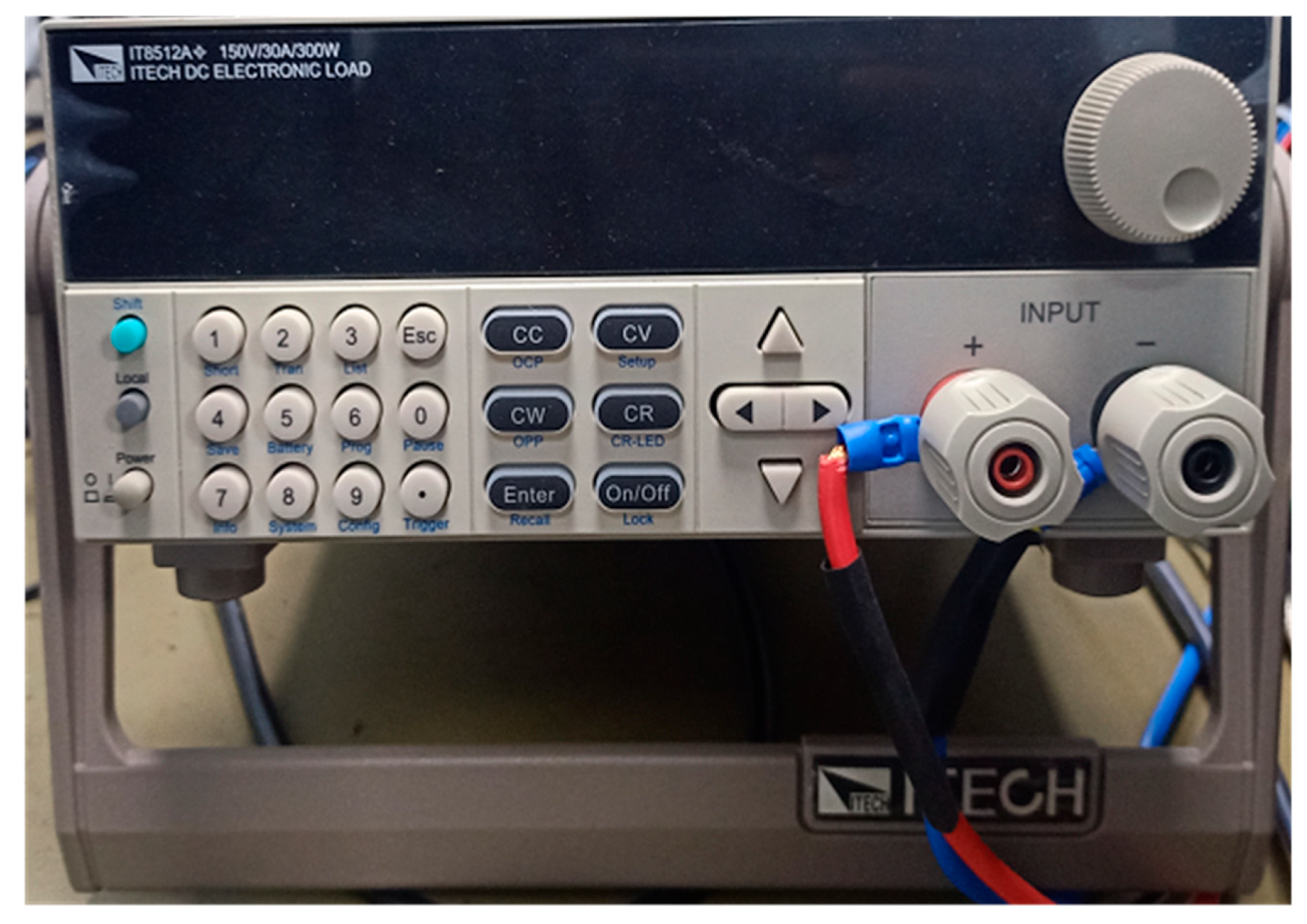
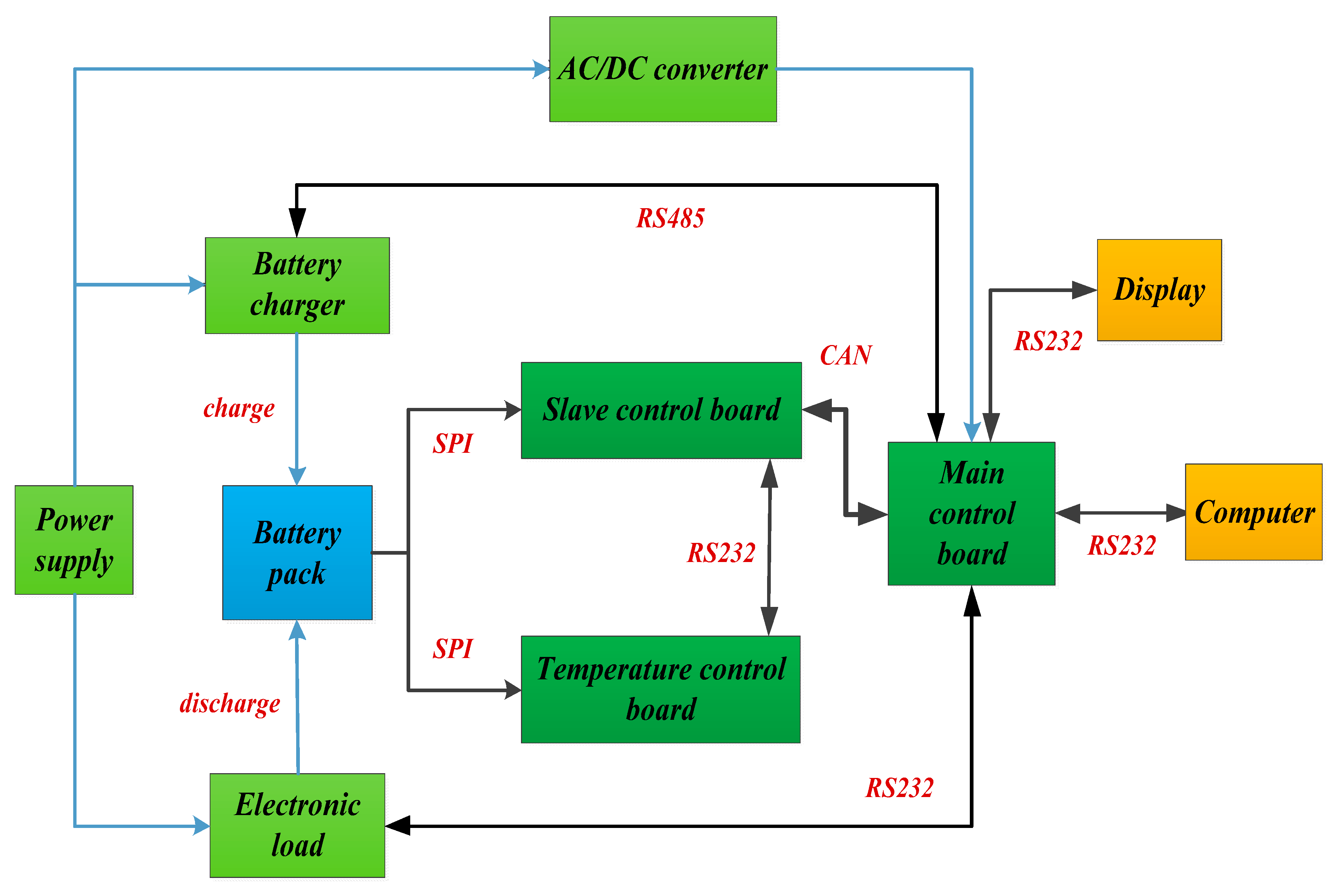


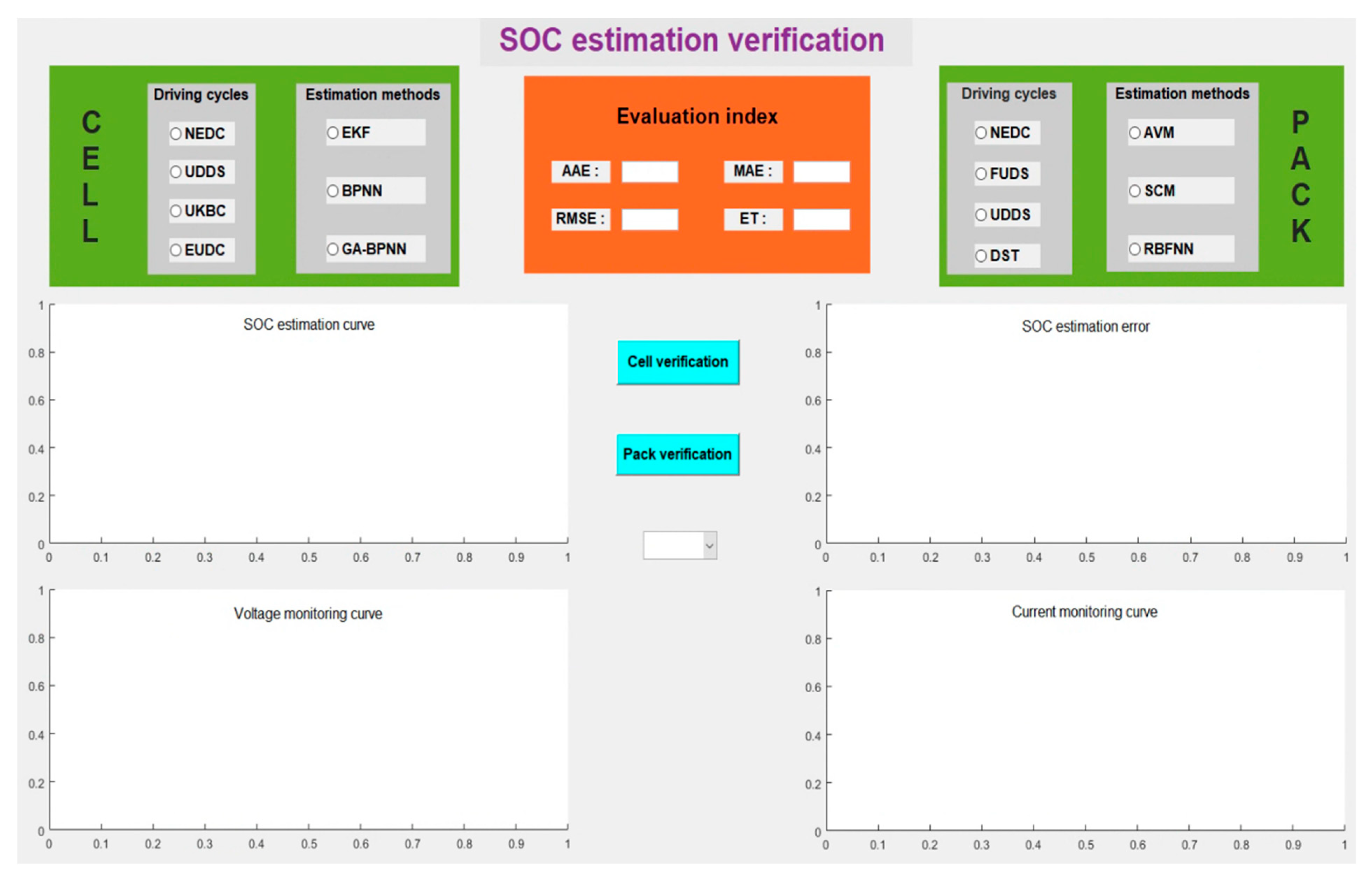
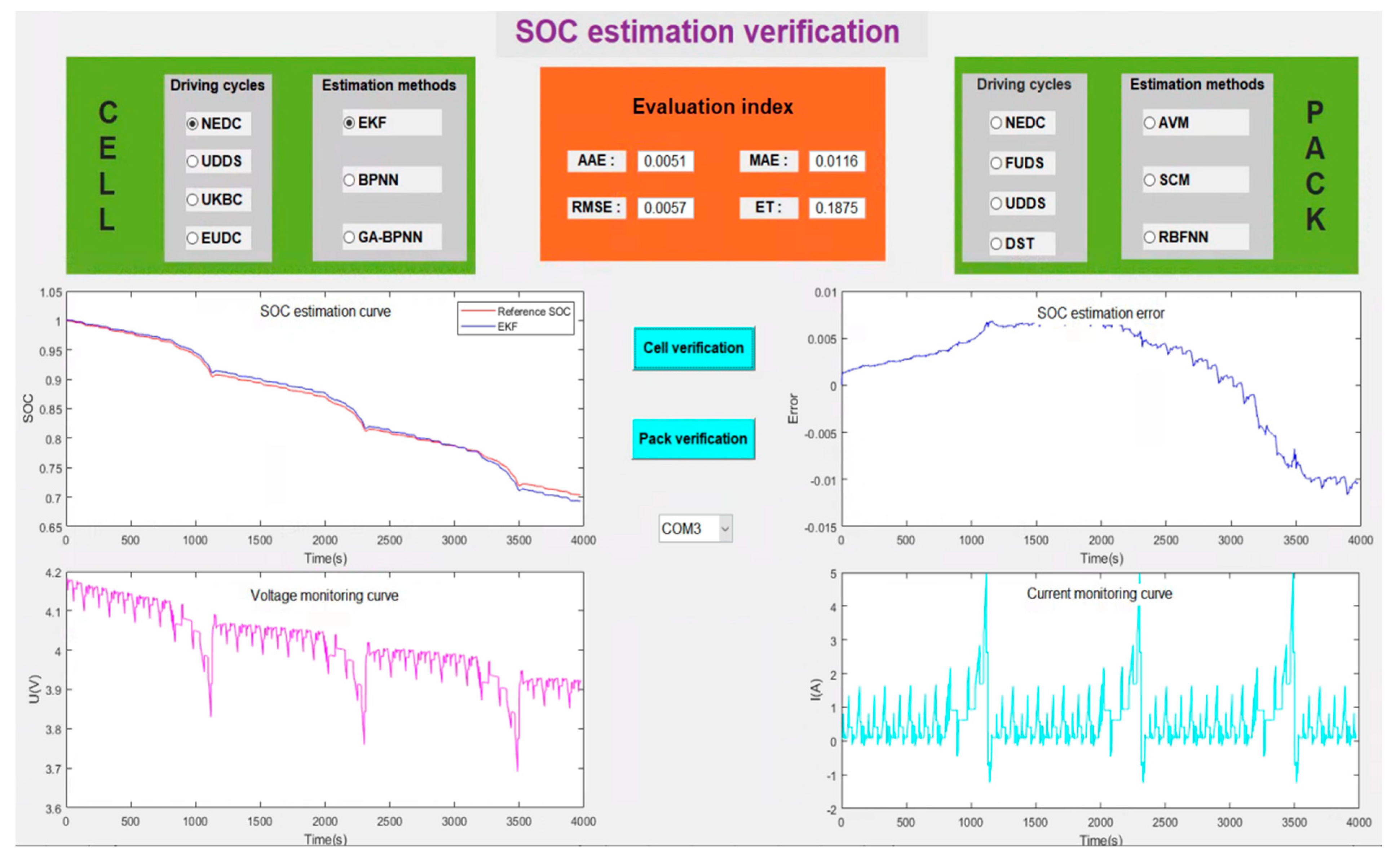
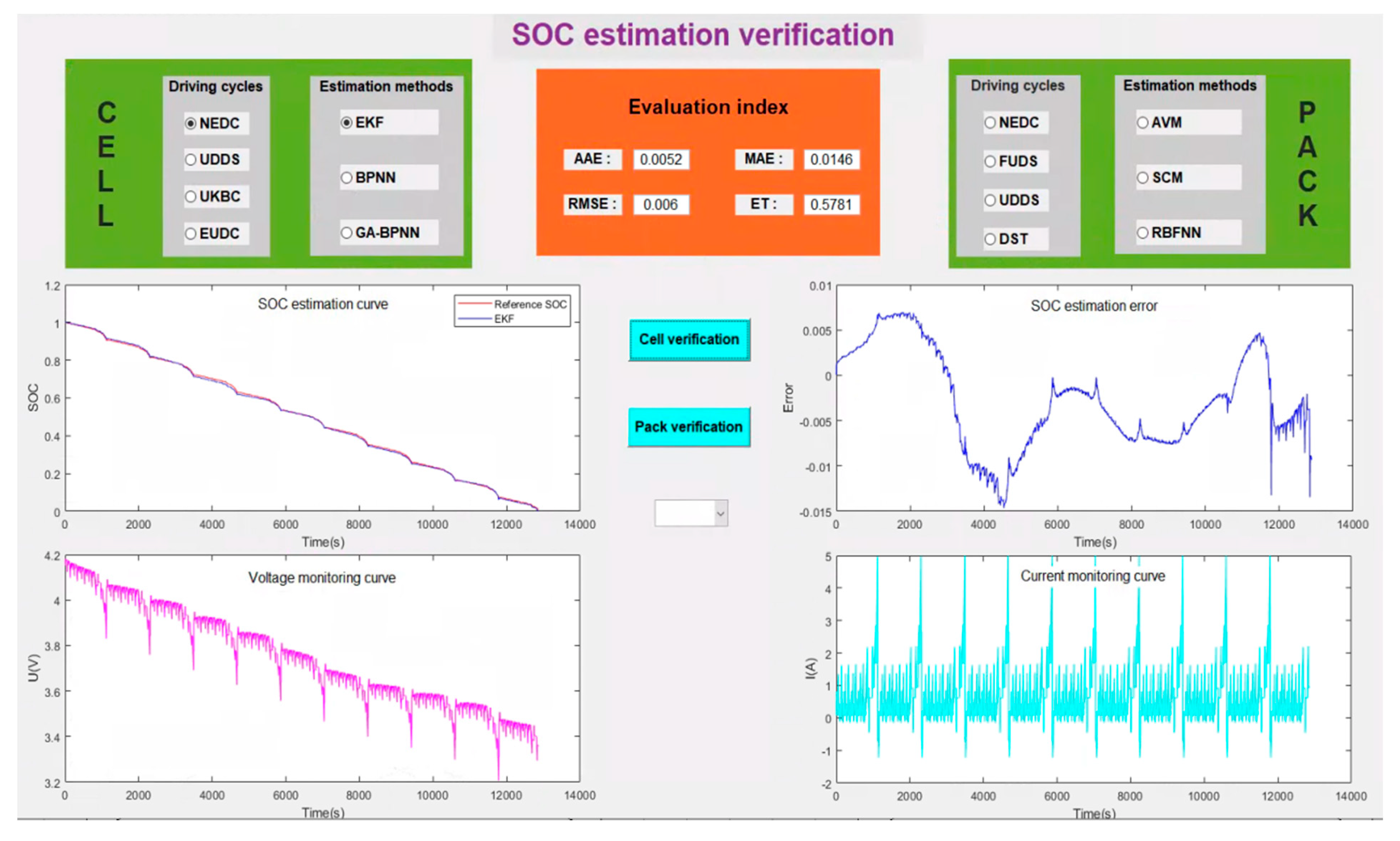
| Projects | Parameters |
|---|---|
| Operating voltage range | 19 V~34 V |
| Operating temperature range | −40 °C~85 °C |
| Operating humidity range | 0~85% |
| Voltage monitoring range of battery cell | 0 V~5 V |
| Voltage sampling accuracy of battery cell | ≤±1 mV |
| Sampling frequency of cell voltage | <30 mS |
| Total voltage monitoring range | 20 V–150 V |
| Total voltage monitoring accuracy | ≤0.5% FSR |
| Temperature measurement range | −40 °C~125 °C |
| Temperature measurement accuracy | <±1 °C |
| Current monitoring range | −40 A~40 A |
| Current monitoring accuracy | ≤±40 mA (<0.1%) |
| Current sampling frequency | ≥50 Hz |
| Balanced control mode | Passive equilibrium |
| Number of external CAN interfaces | 2 channels |
| Number of main control relay control channels | 5 channels |
| Equipment | Available Protocols | Final Selected Protocols |
|---|---|---|
| Programmable electronic load | RS232 | RS232 |
| RS485 | ||
| Display | RS232 | RS232 |
| RS485 | ||
| Battery charger | RS485 | RS485 |
| Upper computer | RS232 | RS232 |
| Main control board | CAN | CAN |
| Temperature control board | RS232 | RS232 |
| Voltage acquisition | SPI | SPI |
| Current acquisition | SPI | SPI |
| Temperature acquisition | SPI | SPI |
Publisher’s Note: MDPI stays neutral with regard to jurisdictional claims in published maps and institutional affiliations. |
© 2022 by the authors. Licensee MDPI, Basel, Switzerland. This article is an open access article distributed under the terms and conditions of the Creative Commons Attribution (CC BY) license (https://creativecommons.org/licenses/by/4.0/).
Share and Cite
Xia, B.; Zhang, G.; Chen, H.; Li, Y.; Yu, Z.; Chen, Y. Verification Platform of SOC Estimation Algorithm for Lithium-Ion Batteries of Electric Vehicles. Energies 2022, 15, 3221. https://doi.org/10.3390/en15093221
Xia B, Zhang G, Chen H, Li Y, Yu Z, Chen Y. Verification Platform of SOC Estimation Algorithm for Lithium-Ion Batteries of Electric Vehicles. Energies. 2022; 15(9):3221. https://doi.org/10.3390/en15093221
Chicago/Turabian StyleXia, Bizhong, Guanyong Zhang, Huiyuan Chen, Yuheng Li, Zhuojun Yu, and Yunchao Chen. 2022. "Verification Platform of SOC Estimation Algorithm for Lithium-Ion Batteries of Electric Vehicles" Energies 15, no. 9: 3221. https://doi.org/10.3390/en15093221







